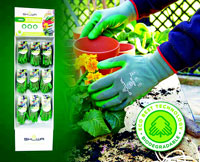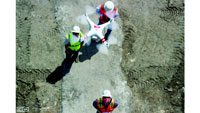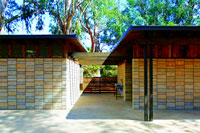Qatar’s first FIFA 2022 World Cup stadium to be ready by 2016
By Mary Sophia
Qatar said that it will complete work on Khalifa International Stadium, one of the 12 proposed venues for 2022 FIFA World Cup matches, by the end of next year.
Originally built in 1976, the 20,000-seater Khalifa International stadium is being renovated to fit FIFA regulations and will host group stage and quarter final matches during the football tournament in 2022.
As per the plans, the stadium will have a new building in its east wing while a single roof will be built to cover the entire seating area. The Aspire Zone Foundation, one of the stakeholders of supreme committee for delivery and legacy, is in charge of construction works on Khalifa International Stadium, a statement said.
Officials said that nearly 90 per cent of the structural concrete has been laid and the process will be fully completed within the next two months. Around 42,000 cubic metres of structural concrete have been poured till now, the statement said. The skeleton of the stadium is expected to be ready by the end of this year.
“Khalifa International Stadium is moving to new heights with structural work in concrete and steel, and the vertical structure is now at level eight while strengthening works are also underway,” said Aspire Zone Foundation’s project manager Mansoor Saleh B. Al Muhannadi.
“We expect the stadium to be handed over by the main contractor at the end of 2016.”
Following renovation, the stadium, fully air conditioned, will be able to accommodate 40,000 spectators. It will also comprise of food courts, shops, a VIP lounge and a health centre in the newly constructed east wing. Khalifa International Stadium will also be well connected to two new metro stations planned in the vicinity.
Qatar, which won the rights to host FIFA 2022 World Cup in 2010, has been mired in controversies including corruption claims regarding its bid to host the tournament. Many of the projects that were planned for the tournament are also facing delays.
The Gulf state planned to spend around $200bn on new infrastructure projects, while the stadiums were estimated to cost around $4bn to build, as per the Ministry of Business and Trade. But rising costs from continuous delays forced authorities to cut down the number of new stadiums from 12 to eight last year. It later decided to construct eight new stadiums and renovate four older ones for the mega event.
In addition, Qatar has also been criticised for mistreating scores of migrant workers, brought in to construct the stadiums for the World Cup.
Field trials of self-healing concret
Self-healing concrete uses a combination of shape memory polymers, microcapsules and microbial healing to reduce or slow down the effects of deterioration due to ageing or damage. The aim is to improve the durability of concrete structures.
Costain is one of the industrial partners of the Engineering & Physical Sciences Research Council (EPSRC)-funded Materials 4 Life research project and has been sponsoring research by Cardiff, Cambridge and Bath Universities into the materials.
The contractor is building a trial structure at its the Heads of the Valleys highways project to give the research team an opportunity to monitor the performance of the material in a real site-based environment.
Costain civil engineer Oliver Teall, who is on secondment to Cardiff University where he is completing a PhD, explained: “We’ll be building a full-scale wall structure with a number of concrete panels. Into each panel we will incorporate different combinations of self-healing techniques. These will be loaded to artificially damage them, and then monitored to see how they react and recover over time.
“We plan to start testing at the end of September, running for a minimum of six months. From this trial we should gain an insight into the feasibility of constructing a full-scale structure with these techniques and their early-stage effects on structural properties.
“We’ll be looking at the effect of the healing techniques on areas such as stiffness, permeability and the mechanical damage recovery of the trial panels.”
Biodegradable, Synthetic Work Glove.
UK-headquartered Globus has launched what it claims is the world’s first fully biodegradable, synthetic work glove.
 |
The Showa 4552’s liner and sponge nitrate feature the manufacturer’s Eco Best Technology (EBT), and have been designed to protect workers from hand injuries. The glove has applications within a range of sectors, including construction, highways, logistics, landscaping, maintenance, and manufacturing, according to GlobusSteve Shale, marketing manager at the manufacturer, said: “As well as feeling comfortable, and with a durable palm, |
customers are very impressed that the Showa 4552 glove deals responsibly with its end-of-life disposal, seeing it as a positive step forward as well as enhancing a company’s environmental credentials.” Globus says that without its EBT additive, nitrile can take decades to biodegrade and break down in landfill areas. The company claims that in contrast, Showa 4552’s biodegradation is far more rapid, typically taking just 24 months.
 |
The Showa 4552 also boasts a 15-gauge lightweight liner, and sponge nitrile coating to facilitate grip. The nitrile-coated palm is able to retain its grip in oily conditions due to [its] coating’s oil-absorbency properties. The glove protects hands from oils, dirt, grease, and abrasion when carrying out manufacturing assembly work, machine servicing, refuse collection, warehousing, logistics, and other tasks. |
Stay-in-place (SIP) formwork
By Sophi MacMilan, Chief Executive Officer, Vinyl Council of Australia
Permanent formwork has just been added to the Responsible Building Materials credit in Green Star as a recognition that the use of materials in permanent, or stay-in-place (SIP) formwork is on the rise.
 |
The growing use of this product has the potential to change significantly the way walls are erected, with flow on consequences in the environmental, health and safety aspects of construction. It’s therefore timely to take a closer look at this product and at some of the reasons behind its adoption. |
Concrete has been the material of choice for wall construction for decades. Temporary formwork has traditionally been used to construct poured concrete walls where its function is to shape and support the concrete until it attains sufficient strength to carry its own weight; after which point the formwork is removed.
 |
Timber, plywood and sometimes steel have been the most commonly used materials for formwork. Besides materials, a significant aspect of temporary formwork is that it is relatively labour intensive. Because of its material and labour requirements, the cost of formwork itself can represent 40 to 60 per cent of the total cost of the concrete structure. |
The potential to reduce both material and labour costs has, over the past 10 years or so, led to innovation in formwork systems. Australia has been a key player in this development, establishing world-leading patents and material formulations. Glass-reinforced plastic, fibre-reinforced plastic, thermoplastics (PVC, polystyrene), fibre cement and metals are examples of materials used to pre-fabricate formwork for permanent systems where the materials remain in place for the life of the building. The components can be interconnected to create formwork that can be erected with a high level of efficiency.
Innovative Australian companies are producing modular SIP systems with proprietary components such that different brands of formwork have different connecting moulds and systems. These new systems can be used to replace load-bearing conventional precast concrete, tilt-up or masonry block walls and are today used for basements, stair and lift shafts, blade columns, irrigation tanks, retaining walls and other areas, and in buildings 30 storeys high.
Temporary formwork has been used for as long as poured concrete walls have existed. It is a well-established product which the building industry as a whole knows inside-out. So what factors are leading to this rise in the use of permanent, or stay-in-place, systems?
Although concrete is now the material of choice for construction, it is not devoid of problems. One of the reasons for it to be used is its high compression strength. However, concrete usually requires reinforcement with rebar because of its poor tensile strength. It is also prone to cracking under sustained pressure, such as in basements and retaining walls. Because of its porous nature, it can develop 'concrete cancer' (usually caused by water penetration). The extent of this issue can be ascertained by the amount of industry discussion, particularly in Australia. Strata Community Australia has warned of an "epidemic" of concrete cancer in Australia, in part due to a major proportion of our property assets being in coastal locations; the exposure to salt and water accelerating the rate at which steel reinforcements might rust.
Using SIP formwork helps overcome these problems as the concrete is sealed or protected from the environment by the formwork for the life of the building. The connectors in the latest SIP formwork systems facilitate concrete flow and consolidation and there’s usually no need to vibrate the concrete.
In the case of thermoplastic SIP formwork, the interlocking system of the modules completely seals the joints and the polymer effectively acts as a waterproofing membrane, a feature that can be particularly beneficial for basement walls. Some systems allow a reduction in the quantity of cement required, and an increase in the amount of fly ash or aggregates used as a substitute without raising concerns of concrete cancer.
Besides these technical aspects of permanent formwork systems, they have been shown to have the potential to reduce the environmental impacts as well as health and safety risks on construction sites. Some of the latest SIP formwork systems reduce the quantity of steel reinforcement required, therefore playing a significant part in reducing materials consumption and, importantly, the embodied energy of the built form.
In addition, there’s no need for stripping SIP formwork, which together with their light weight and ease of installation can improve health and safety on site and reduce injury risk. However, because of their light weight, some modular systems can be more susceptible to wind load during installation and before fixing; they may need bracing before the concrete pour.
It’s also critical to ensure that any modifications to a SIP formwork system’s mould design or the use of a combination of two systems’ components is checked and signed off by suitably qualified people because of the proprietary, and therefore differing, nature of systems in the market. The lack of familiarity with these construction systems and a traditional conservativeness in the building industry is likely to slow the rate at which they might replace temporary formwork.However, those companies that have started to use SIP formwork cite cost savings,construction time savings and ease of installation as key attractions to the systems.
 |
The decision to use permanent over traditional formwork or masonry work can also be driven by site requirements, particularly where there are water issues and retaining wall requirements; and project design requirements such as multi-storey underground basements. |
From an environmental and safety perspective, these systems have been shown to benefit projects through transport energy savings, significant reductions in embodied energy of materials, better site safety and reduced long-term maintenance. Some of these systems have also been certified to meet earthquake and bushfire requirements and can therefore contribute to the need in our region for a more resilient built environment.
GBCA’s inclusion of permanent formwork in its Responsible Material Credit recognises its rising use in the building industry, but these construction systems may also represent opportunities to rethink the way we build, the quantities and types of materials we use, the ability to improve housing affordability and the durability of our built environment.
Drone Photography Changing Construction Profitability
“Most of our projects fly quad copters weekly for aerial progress photos, and then as needed for project documentation but we do have a few projects that fly daily or multiple times a day,” says Blake Potts, Rogers-O’Brien Construction’s senior virtual design and construction specialist.
“It started with a project superintendent who was really keen to document all phases of his project. One of the ways he did that was to acquire aerial data twice a day during his job walks,” says Potts. “He would take pictures from the ground and then from air.
“He was able to see things in the aerial photos that would not have been evident from photos taken on the ground. Then he would mark up and archive the photos so that he would have accurate and timely information to work from the next day.
“I think in the future, once the FAA (Federal Aviation Administration) has worked out the kinks, automated flights will take place at least once a day for progress photos and at other times as needed when an activity is taking place on the jobsite that teams would like to document – like a concrete pour or steel erection.”
Since deploying their first unmanned aerial vehicle (UAV) in early 2013, Dallas-based general contractor Rogers-O’Brien Construction has built a fleet of ten of the remote-controlled aircraft. Uses include investigating building warranty claims, settling disputes with subcontractors and routine progress photos.
Automated flights will, assuming Google and Amazon will convince regulators to allow them, willpave the way not only for more-frequent aerial progress updates, but also for using photos togenerate point clouds that can be used to creating 3D models of work in progress. It’s a feature thatPotts believes will revolutionize the precision with which contractors gauge progress and keep projects on schedule and budget.
Cement-Free Concrete Blocks a Reality
Ever since manufacturers developed techniques to make them cheaper than traditional clay-fired bricks, concrete blocks have been one of our most ubiquitous construction materials.
 |
However, this ubiquity comes at a price: worldwide, the production of concrete accounts for around 5% of all man-made carbon dioxide emissions, and concrete blocks (as opposed to in-situ concrete or concrete panels) contributes a significant portion of these emissions. |
http://images.adsttc.com/media/images/55de/18c9/e58e/ce19/1f00/000b/medium_jpg/Watershed-Materials_Arch-Daily_150825_08.jpg?1440618692
To curb these runaway carbon emissions, a California-based company called Watershed Materials is developing alternatives to the traditional concrete block which uses less cement, dramatically reducing the amount of carbon dioxide produced; they even have a product in the works which they hope will offer a widely applicable concrete block alternative which uses no cement at all.
Source: www.archdaily.com/772567/watershed-materials
Novel Scissor-Like Bridge Structure for Use during Emergencies
Natural disasters include earthquakes, floods, tsunamis, and landslides. They can occur anywhere in the world. The damage caused by such disasters to infrastructure such as bridges necessitates a rapid response to rescue survivors and deliver medical care to the injured within a new set of localized constraints. In many disasters, urgent medical attention can be delivered to injured survivors only if a new bridge is constructed or deployed rapidly. 4. In certain situations, an emergency bridge may be needed even where no professional structural engineers are available.
Dr. Ichiro Ario, Assistant Professor at the Institute of Engineering, Hiroshima University proposed and presented a new type of foldable/deployable bridge with a scissor mechanism called Mobile Bridge (MB) at a symposium of the Japan Society of Civil Engineers (JSCE). A test of the Mobile Bridge® Version 4.0 (MB4.0) over a real river demonstrated its viability for practical use. During the test, the bridge was set up without any foundation work, and a vehicle could easily travel across it. This was achieved safely with very few people and without any problems. MB4 can be deployed and folded quickly, and it therefore provides highly efficient construction and easy transportation.
MB can be deployed in a wide range of areas and has numerous applications. Many existing bridges are in a poor state of repair owing to poor maintenance and overuse. Smaller bridges can be kept operational using MB. This affords the advantage of keeping bridges fully operational without interrupting traffic and causing further damage to the existing bridge by traffic.
Background of development based on Origami
MB has a scissor-like structure that is connected to the main structural members to form an "X" shape; this enables expansion and contraction while retaining strength. The idea for this new bridge comes from academic studies on buckling based on Origami (Japanese traditional paper craft), which has attracted the attention of researchers in space development and other fields.
MB4.0 is the world's fastest, largest, strongest, and lightest expanding temporary bridge. In addition, it is the fastest to set up. Because the bridge and its lanes are expanded simultaneously, the bridge is ready for traffic as soon as it is fully expanded.
Source: http://www.sciencedaily.com/releases/2015/07/150722081121.htm